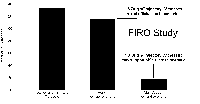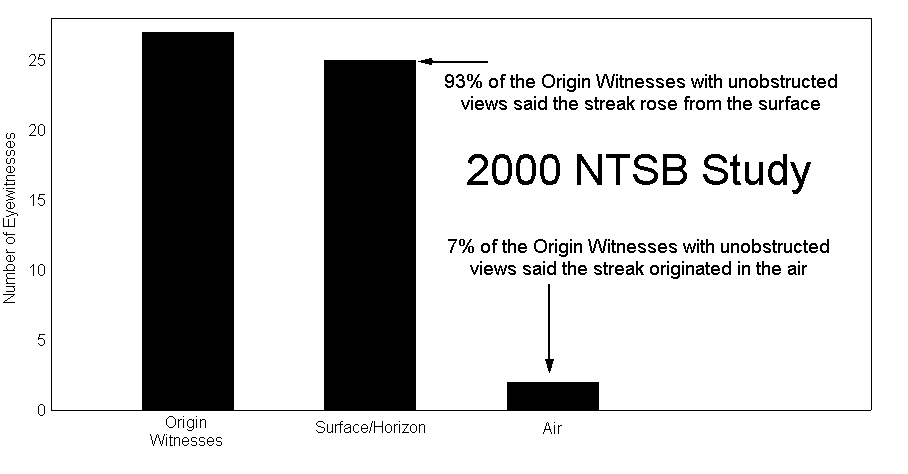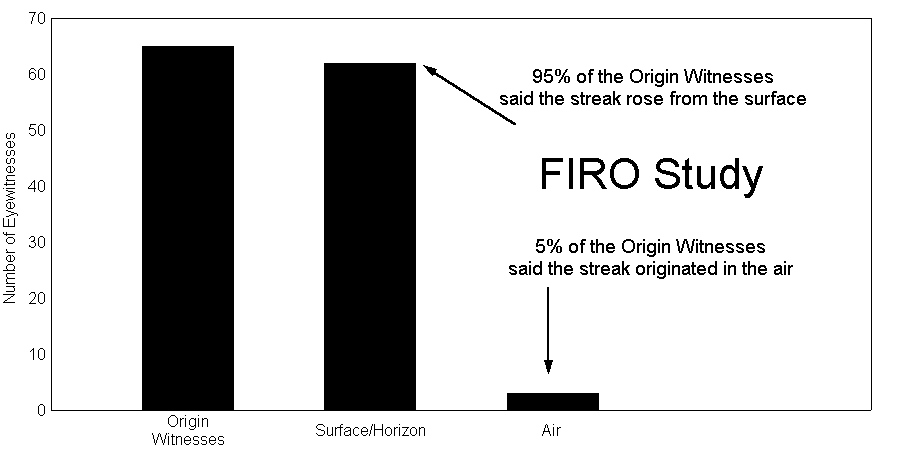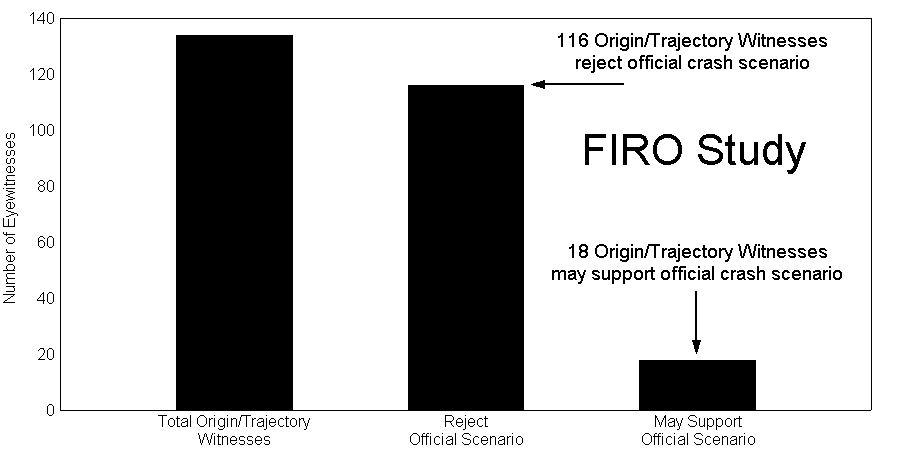 | |
Eyewitness statistics for witnesses who described the origin and/or trajectory of a streak of light (click to enlarge).
|
Review of the Official TWA Flight 800 Witness Reports T.F. Stalcup and T. Shoemaker
Flight 800 Independent Researchers Organization May 30, 2001
Abstract
This review analyzes 670 individual eyewitness accounts as recorded in an FBI database of witness interview summary documents. After a detailed statistical examination of the database, the authors have determined that most witness descriptions of a rising streak of light seen moments before the crash are inconsistent with the National Transportation Safety Board's explanation of it.
Introduction TWA Flight 800 crashed eight miles south of Long Island, New York ten minutes after takeoff. Moments before the crash, witnesses observed a streak of light rise from the ocean surface. These observations initially caused FBI agents "to suspect that a missile might have been used against flight 800"[1]. Ultimately however, the NTSB concluded that the witnesses mistook the aircraft itself for a missile.[2]
Statistics from the official eyewitness database challenges a key NTSB conlcusion. Most significantly, eighty-six percent of the witnesses who described the motion and/or origin of the rising streak reject the NTSB's explanation. Many of these witnesses observed the streak rise off the surface when Flight 800 was flying 2.6 miles above it. Other witnesses reported seeing the streak flying in a different direction from that of Flight 800 and/or seeing the streak collide with Flight 800 (see "FIRO Witness Statistics" below). The remaining fourteen percent did not provide information on the srtreak's origin and therefore could not be excluded from the NTSB's explanation for it.
Procedures
Flight 800 Independent Researchers Organization (FIRO) reviewed all official FBI witness interview summaries that were publicly released in April of 2000. From this review, 182 witness accounts were located that included descriptions of a rising streak of light seen moments before the crash. FIRO then compared its statistics with the NTSB's and found excellent agreement with two separate NTSB reports, as can be seen in Figure 4 below.
After noticing that the NTSB did not compare the observations of the 182 eyewitnesses who saw a rising streak of light with their official explanation for it (TWA Flight 800 climbing sharply), FIRO took the additional step of analyzing each of the 182 accounts to determine whether or not the individual descriptions of the streak were consistent with the NTSB explanation. Trajectory and origin data for the rising streak were extracted from each witness account for use in this analysis. Witness accounts that described two separate objects in the air were also compared with the NTSB explanation.
Factual Overview At approximately 8:30 PM (EDT), on July 17, 1996, at an altitude of 13,800 feet, TWA Flight 800, a Boeing 747, exploded and crashed into the Atlantic Ocean about eight miles south of Long Island, NY. The jetliner was on a regularly scheduled flight from John F. Kennedy International Airport to Charles De Gaulle International Airport in Paris, France. Good weather and high summertime populations allowed hundreds to observe the crash. Officially, no less than 670 eyewitnesses were interviewed in the immediate aftermath.[1] The FBI conducted most witness interviews and restricted the NTSB from participating. FBI agents summarized handwritten notes taken during each interview. 458 of these summaries (FBI 302's) were made available to a "Witness Group," formed by the NTSB.[3] Approximately two years after the crash, the original NTSB Witness Group had disbanded and another formed. The second NTSB Witness Group was given 670 FBI eyewitness interview summaries. Document readers extracted statistical information from each summary.[4] The NTSB held two public hearings on the crash. One was held in December of 1997, where the original Witness Group released the "Witness Group Factual Report."[3] The other was held in August of 2000, following the release of two more reports (the "Witness Group Chairman's Factual Report,"[4] and the "Witness Group Study"[1]) and thousands of pages of raw witness documents, including 670 official FBI eyewitness summaries. At the writing of this report, the witness database is incomplete, with many documents unaccounted for by the FBI.[5] Missing Witness Materials The FBI withheld 212 official witness summaries from the NTSB for more than a year after the crash.[3, 4] The original NTSB Witness Group was given access to 458 FBI witness summaries, which were alleged to represent the total number of witnesses in the October 1997 NTSB "Witness Group Factual Report."[3] But later it was determined that 670 eyewitnesses were interviewed by September of 1996.[4] Among the 212 official witness summaries withheld by the FBI were all accounts of a streak of light colliding with an aircraft. Besides withholding witness evidence during the initial phase of the NTSB's investigation, the FBI listed and continues to list much of its witness materials as "unable to locate."[5] Among these materials are the results of a study to triangulate the origin of the rising streak of light. According to FBI documents, investigators attempted to determine the origin of "an unusual 'flare' launched in the direction of flight # 800" before it exploded and crashed.[7] Investigators from the Suffolk County Police Department, FBI, and U.S. Defense Intelligence Agency conducted two such studies. The results of one study (included as Attachment 2) appear to have been deleted. Immediately following the phrase "the following results were obtained:" the remaining three-quarters of the page is blank and no other page follows.[8] In addition, several witness graphics and sketches are also missing today. Dozens of pictures and graphics were obtained from witnesses, depicting their observations on the night of the crash. Some of these sketches have been produced by the FBI and depict a "streak" rising from the surface and exploding in the immediate vicinity of Flight 800. These sketches are included in Attachment 1. However, several sketches obtained from witnesses who gave detailed descriptions of the streak are among the witness materials listed by the FBI as "unable to locate."[5]
Witnesses Banned From Public Hearing In December of 1997, the NTSB scheduled a weeklong public hearing on its Flight 800 investigation. Among the items slated for discussion were the eyewitness reports. Five days before the hearing began, the FBI pressured the NTSB to exclude all discussion of witness accounts and to disallow any eyewitness from testifying. In a December 3, 1997 letter to NTSB Chairman Jim Hall, FBI Assistant Director James Kallstrom wrote: "the FBI…objects to requests to disclose or include in the public docket of any FBI FD-302s or summaries of FD-302s prepared by the NTSB that report the results of any interviews or reinterviews of the 244 eyewitnesses whose reports were examined by the CIA in connection with it's analysis and to calling any eyewitnesses to testify at the public hearing."[6]
Chairman Hall complied with the FBI's requests.[9] No eyewitnesses testified, nor were any witness accounts discussed during the live, five-day telecast of the hearing. The public would have to wait another two and a half years (or four years after the crash) before the National Transportation Safety Board would publicly address or release the eyewitness evidence.
1997 NTSB Study [3]At the December 1997 hearing, hard copies of the NTSB "Witness Group Factual Report"[3] were available. That report contained the following witness statistics: Total Witness Accounts: 458 Streak of Light Witnesses: 183 Fireball Witnesses: 339 Reported Origin of Streak: 102 Originated from Surface: 96 Originated in Air: 6 Out of 183 witnesses who saw a streak of light, 102 gave information regarding its origin, according to the 1997 NTSB study. Of these witnesses, 94% said it rose from the surface (see Figure 1 below). 
(click on image to enlarge) Figure 1 : NTSB statistics regarding witnesses who reported the origin of a streak of light (released in December of 1997; click on image to enlarge). 2000 NTSB Study [1]In August of 2000, two and a half years after the Baltimore hearing, the NTSB held its second and final Flight 800 hearing in Washington D.C. Once again, witnesses were not allowed to testify; however their observations were discussed within the context of a new "Witness Group Study"[1]. That study contained the following witness statistics: Total Eyewitness Accounts: 670 Streak of Light Witnesses: 258 Fireball Witnesses: 599 Reported Origin of Streak: 33 Originated from Surface/Horizon: 25 Originated behind obstruction: 6 Originated in Air: 2 Streak traveled vertically or nearly so: 38 Airplane/Streak Witnesses (saw streak and airplane separately): 7 
Figure 2 : NTSB statistics regarding witnesses who reported the origin of a streak of light (released in April of 2000; click on image to enlarge). Of the "origin witnesses" with an unobstructed view of the horizon, 93% said the streak rose from the surface or horizon, according to the NTSB 2000 study (see Figure 2 above). This is in good agreement with the same statistic in the 1997 study, where 94% reported the surface as the origin. But other values between the two studies do not match. The 1997 study reported a total of 458 eyewitness accounts, while the 2000 study reported a total of 670. As discussed above, the FBI withheld 212 witness summaries from the original NTSB Witness Group, causing that group to report a deficient total.[3] Other differences between the studies can be attributed to varying definitions of similar witness categories. The 2000 study tended to use strict definitions when classifying the witness accounts, which reduced the total number of origin witnesses in the 2000 study. In some cases, the strict definitions used by the second witness group reduced the actual number of accounts that could support or reject a particular theory for the crash. The "Airplane/Streak" definition minimized the number of witnesses who reported two distinct objects in the air by requiring witness accounts to include the immediate identification of one object as an airplane. This requirement excluded all witnesses who reported a midair collision between two objects, but did not immediately recognize one as an aircraft. For example, consider the testimony of Air National Guard Captain Chis Baur. Captain Baur stated that a "pyrotechnic device...came from the left and went to the right. And it made the object on the right explode."[10] Baur viewed the crash from an Air National Guard Black Hawk helicopter. After observing an airborne "pyrotechnic device" cause another object to explode, he immediately flew to the area to investigate. Once on scene, he and his crew determined that "the object on the right" was an airplane. However, because Baur did not immediately recognize one object as an airplane, he did not fall within the NTSB definition of an Airplane/Streak witness. Many other witnesses were excluded from this category for similar reasons. According to the NTSB, seven witnesses fit the Airplane/Streak definition, including Witness 73. Witness 73 stated that "While keeping her eyes on the aircraft, she observed a 'red streak' moving up from the ground toward the aircraft at an approximately a 45 degree angle."[11] Witness 73 was closer to the crash site than Captain Baur and was already watching Flight 800 when she noticed a streak rise from the surface and collide with the jetliner. Although Baur and witness 73 both saw an airborne collision before viewing the fiery descent of Flight 800, only witness 73 and six others fit the NTSB Airplane/Streak definition. In the 1997 study, there is no Airplane/Streak definition at all, because the FBI withheld these accounts from the original NTSB Witness Group. It was not until 212 additional eyewitness summaries were disclosed that any Airplane/Streak witnesses were located.[1] NTSB Conclusions The NTSB concluded that the observed rising streak was Flight 800 after it exploded. Officially, the streak was attributed to Flight 800 in flames, as it climbed into the air on an eastern track. The cause of the initial explosion aboard Flight 800 has not been determined, but federal investigators believe it involved the presence of volatile vapors in the jetliner's center fuel tank.[12] NTSB Witness Group Chairman Dr. David Mayer explained the above crash scenario during a presentation at an August 2000 NTSB hearing on the crash. Dr. Mayer said that "most of the 258 streak of light accounts" were consistent with the above scenario and that fifty-six were not.[2] The fifty-six witnesses Mayer mentioned that conflicted with the official crash scenario included those who saw the streak rise from the surface or rise vertically. Mayer did not consider other witnesses that conflicted with the NTSB crash scenario, such as those who saw the streak collide with or travel in a direction that opposed Flight 800. Because of this and other oversights, FIRO conducted its own review of the witness evidence.
FIRO Review FIRO researchers reviewed the NTSB witness studies and 670 FBI interview summaries. Although there were inconsistencies in some of the witness summaries, a significant number of consistent witness accounts were located. Witness accounts with detailed descriptions of a rising streak of light were analyzed and compared with the official crash sequence.
FIRO Witness Statistics The following witness statistics were extracted from the database of 736 FBI Flight 800 witness interview summaries (670 were eyewitnesses): Rising Streak of Light (RSL) Witnesses: 182 These witnesses were the earliest observers to airborne events related to the crash of Flight 800. Most RSL witnesses saw a rising streak and followed it until it exploded in midair. The FBI summarized the testimony of Witness 8, a typical RSL witness: "[he] saw a red object flying upward. [He] stated that he described the object as a flare when he called the incident into the Coast Guard but that it was actually much bigger than any flare he had ever seen. As the 'flare' lifted into the sky he next saw a big explosion of a large red color."[11] Origin Witnesses: 67 Origin Witnesses provided FBI agents with information regarding the origin of the observed rising streak of light. Witness #9, included within this category, "was facing east when he saw a streak of red orange light come up from the bay or the ocean and head straight up or at a slight one o'clock angle."[11] Witness 9's account is consistent with 93% of the origin witnesses (Figure 3) who also said the streak rose from the surface. 
Figure 3 : FIRO statistics regarding witnesses who reported the origin of a streak of light (click on image to enlarge).Sixty-two (95 %) origin witnesses said the streak rose from the surface and three said it originated in the air (see Figure 3). A comparison of origin witness statistics from two NTSB studies with those calculated by FIRO reveal remarkable consistencies. Each study found an overwhelming majority of origin witnesses with a clear view of the horizon who saw the streak rise from it (see Figure 4). 
Figure 4 : Comparison between FIRO and NTSB statistics (click on image to enlarge). Ascent Angle Witnesses: 56 Ascent Angle Witnesses provided FBI agents with information regarding the angle of ascent of the observed rising streak of light. Of these witnesses, forty-nine (87%) said that the streak rose vertically or nearly so. Witness #9 above is a typical ascent angle witness. Compass Witnesses: 77 Compass witnesses gave information that could be used to establish the direction the streak was traveling. Thirty-five described its motion as eastward and thirty-four described it as moving westward. Three compass witnesses said the rising streak moved due north, seven said due south. Witness #326, a typical compass witness, "saw a red glowing object ascending from the tree tops...[then it] arced from the west to the east as it ascended."[7] Two-Object Witnesses: 21 These witnesses reported two distinct objects in the air. A majority of these witnesses recognized one object as an airplane and the other as a streak or flare. Thirteen two-object witnesses recognized one object as an aircraft. Thirteen also said that one object impacted with the other. Seven recognized one object as an aircraft and reported seeing a separate object impact with it. Witness 88, a typical two-object witness, "stated that the bright red object ran into the airplane and upon doing so both the plane and the object turned a real bright red then exploded into a huge plume of flame...He stated he felt the bright red object struck the plane towards the cockpit area."[11] Origin/Trajectory Witnesses: 134 Origin/Trajectory Witnesses include all official witnesses who reported the origin and/or trajectory of a rising streak of light. This particular category of witnesses is significant because these accounts are the only ones that the NTSB could have relied upon when reaching their conclusion of what the streak was. To verify or refute the NTSB explanation for the streak, these accounts must be compared to what is known about the final moments of Flight 800. According to the NTSB's radar and debris field analyses[13], the following facts are known about Flight 800's breakup sequence: 1) Flight 800 began its "crippled flight" at an altitude of 13,800 feet (2.6 miles or ~ 4 km).[13] 2) Flight 800 was heading east (to Paris) when it began to break up.[13] 3) NTSB: "Flight 800 was never ascending straight up"[2] 4) NTSB: "Flight 800 in crippled flight didn't originate at the surface"[2] Contrary to these facts, most Origin/Trajectory witnesses saw the streak originate at the surface and/or ascend straight up. Thirty-four witnesses saw the streak rise westward--a direction the crippled jetliner never traveled.[13] 
Figure 5 : Origin/Trajectory witness accounts compared with the official crash scenario (click on image to enlarge). As shown in Figure 5, 116 (86%) of the origin/trajectory witnesses reject the official explanation for the streak.
Discussion
Rather than openly address eyewitness observations, both the FBI and NTSB on various occasions suppressed the witness evidence:
1) The FBI withheld the accounts of 212 witnesses from the NTSB for more than one year after the crash. All witness accounts with descriptions of a streak colliding with an aircraft were concealed from the NTSB in this withheld data.[3, 4]
2) The FBI ostensibly lost the results of a study to determine the origin of an alleged surface-launched object seen before the crash. Those results are officially listed as "unable to locate" by the FBI.[5]
3) At the first public hearing on the crash, the FBI prevailed upon the NTSB to prohibit any discussion of the witness evidence.[6]
4) Official witness sketches that purport to show a surface-launched object cause the crash have never been discussed or addressed in any official report or public hearing on the crash.[4]
5) The witness evidence was withheld from the public until April 2000, almost four years after the crash.
6) At the final public hearing on the crash in August 2000, the NTSB dramatically under-reported the number of witness accounts that conflicted with their proposed crash scenario.[2]
Evaluation of official witness materials reveals that a large majority of the relevant witness accounts do not support the official crash scenario and instead clearly reject it. Such witness accounts include descriptions of airborne objects rising from the water’s surface to converge with the aircraft in conspicuous exception to the official scenario. These witness accounts include the additional information that the ascending, converging object originated from and then transected parts of the sky never occupied by TWA Flight 800, its wreckage, or the officially purported trail of burning fuel. They describe a streak of light that led to the aircraft rather than trailed from it. Thus, in several ways a significant quantity of the official eyewitness materials refute the most fundamental aspects of the official crash scenario. The questions raised by these witness accounts redirect critical attention towards the official crash sequence. As it stands now, the official sequence is not flexible enough to include the implications of these accounts. For the official sequence to stand, these accounts must be rejected or discredited. And yet these accounts clearly stand on an equal footing with all other witness accounts in detail, clarity, and level of certainty. They even surpass most other accounts in amount of potentially useful information, since they include descriptions of the earliest portions of the crash sequence up to and including the final moments. Taken together these particular witness reports support the conclusion that a separate object was in the air, closing in on TWA Flight 800 just before it exploded. Many witnesses reported that this other object rose from the surface of the ocean, produced a flare-like light, and headed for TWA Flight 800 from a direction not consistent with the eastbound track of the aircraft. It moved quickly and was not observed to have proceeded beyond the position of the aircraft. Witnesses associated it with one or more explosions and the formation of a large fireball, which fell to the sea. TWA Flight 800 itself did not behave in a manner consistent with the observations of these overlooked witnesses. Their observations run contrary to the official crash scenario.
Conclusions This review of federal data gathering, analytical procedures, and public dissemination of official findings concerning TWA Flight 800 witness reports located several problem areas. These areas include the concealment of witness evidence, a failed attempt to explain a rising streak of light, and an under-reporting of observations in conflict with official conclusions. This examination has shown that these areas are not insignificant or isolated problems. Each problem area alone is of sufficient magnitude to raise credible doubts concerning the validity of the NTSB witness studies. Combined, a pattern of neglect and suppression of witness accounts that refute the official theory becomes visible. The dynamic relationships among these areas prevented the NTSB from obtaining timely possession and control of the witness materials, carrying out a rigorous statistical evaluation of the data, and maintaining standards of accuracy in conveying information about the data to the public. In pursuing its study without correcting these problems as they emerged, NTSB officials reduced their ability to reach conclusions solidly grounded to the available data. The perpetuation of deficits within the official investigation has resulted in an incomplete and misleading official report. Independent review of the now-available witness materials indicates that, far from being a closed matter, the TWA Flight 800 witness data today carries investigative utility overlooked by the NTSB during its four-and-a-half years of investigation. The independently demonstrated significant number of witness accounts that clearly refute the official aircraft breakup scenario may well point to implications neglected by officials. The object that witnesses saw rising from the surface, heading west, and exploding can not be explained by Flight 800 at 13,800 feet, heading east and exploding, as officials contend. This object must be adequately accounted for before any federal agency can claim to know the probable cause for the crash of TWA Flight 800. Attachments: 1) Official Witness Sketches 2) 1996 Triangulation Study References:
1. Mayer, D., Witness Group Study Report. NTSB Public Docket, 2000. 2. Mayer, D., NTSB Witness Group Sunshine Hearing Presentation. NTSB Public Docket (hearing transcripts), 2000. 3. Wiemeyer, N., Witness Group Chairman's Factual Report of Investigation. NTSB Public Hearing, Baltimore, MD, 1997. 4. Mayer, D., Witness Group Chairman's Factual Report. NTSB Public Docket, 2000. 5. Schiliro, L.D., August 25, 1998 letter from FBI Assistant Director Lewis D. Shiliro to NTSB regarding missing witness materials. NTSB Public Docket: Appendix EE of Witness Group Chairman Factual Report, 1998. 6. FBI, Letter to NTSB Chairman James Hall: Objections to Hearing Items, . 1997. 7. Mayer, D., FBI Witness Summary: Appendix E. Witness Group Chairman's Factual Report, 2000. 8. FBI, FBI 302 'azimuth intersections' document: CC1-498 prepared by Special Agents W. F. Lynch, P. C. Casazza, and P. Shea. NTSB Public Docket (W# 129, Appendix C, Witness Group Chairman's Factual Report), 1996. 9. Hall, J., Letter to FBI Assistant Director Jim Kallstrom Regarding Objections to Hearing Items. NTSB Communications, 1997. 10. Baur, C., NTSB: Official Interview Transcripts. Witness Group Chairman's Factual Report: Appendix N, 1997. 11. Mayer, D., FBI Witness Summary, Appendix B. Witness Group Chairman's Factual Report:, 2000. 12. NTSB, Final Board Meeting on TWA Flight 800. Transcripts in Public Docket, 2000. 13. Pereira, C., et al., Airplane Performance Study. NTSB Public Docket, 1997.
|

